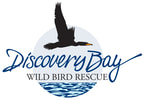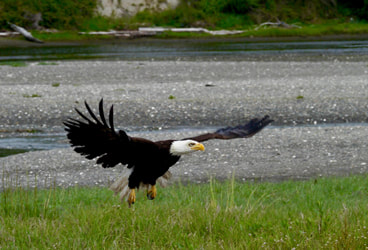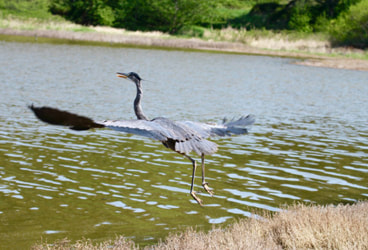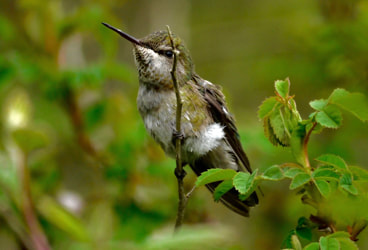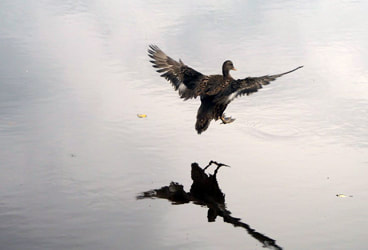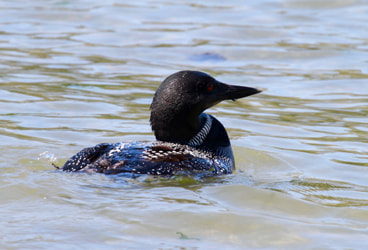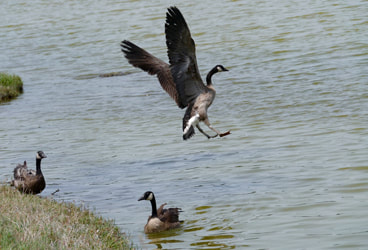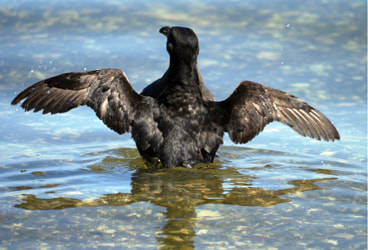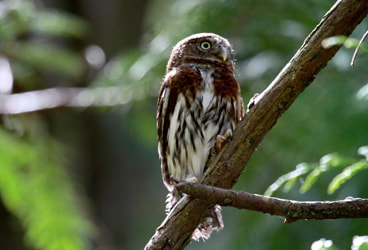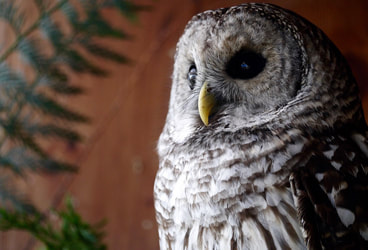Releasing Birds Back To The Wild
Our primary mission is to rescue, rehabilitate and release birds which were injured, sick or orphaned. Each year we rescue and release hundreds of birds, from tiny hummingbirds to songbirds, crows, owls, seabirds and other raptors like hawks and eagles. The greatest joy we get to experience is to witness a bird take their first flight, rejoicing in their rediscovered freedom. However, it costs a lot of money to rescue, rehabilitate, feed and care for an injured wild bird. Sometimes birds live with us for months before they are ready to be released. Any help you can give us by making a tax deductible donation really helps us to continue to do the work we do! You may also consider Adopting one of our Educational Birds. Please enjoy the pictures.
|
This mature Bald Eagle came in from Quilcene where he was found in a hay barn. He was very emaciated weighing less than 5 lbs! Winter months can be hard on wildlife, especially, when there is a lot of competition for food. We also look for other outlying problems which caused them to be thin, like a head or eye injury, or a toxin. It may not be apparent when we receive them so clues to where or how they were found can help us look for other problems. Pay attention to where you find a bird- under a power line, under a window or door, along the freeway- this is important information. This eagle was eventually released by Oak Bay State Park.
Read more about Bald Eagles |
This Great Blue Heron (pictured) was found entangled in fishing net and had scrapes and wounds all over its body and was very thin. At DBWBR we receive these long-legged waders all year round as they get themselves in trouble in many ways. These gangly birds get a bad reputation for eating fish out of ponds and other places where they may not be wanted. We have to learn to share the world with our wild inhabitants so we must find ways to prevent unwanted encounters. Our center is available to answer questions that will help you live with our wild neighbors!
Read more about Great Blue Herons |
In Washington State we have two species of Hummingbirds - Anna's Hummingbirds are year round residents and visit feeders even in the winter. Rufous Hummingbirds are spring visitors. Often times these birds are brought to us after striking windows, or as orphans who have fallen from nests. Many hummingbirds are caught by cats each year! The best way to prevent this is to keep cats indoors! Hummingbirds have specialized requirements- if you find one in distress get it to us right away! This Anna's Hummingbird was raised and released.
Read more about Anna's Hummingbirds |
|
Every spring we raise a lot of orphaned ducklings. Many have been grabbed by a cat or dog, it's important to remember that there are a lot of baby birds, and other animals, being born and raised in the spring. Please keep your dogs on leashes and keep your cats indoors. Outdoor cats kill as many as 3.7 BILLION birds per year in the USA. This mallard, along with many other ducklings, was cared for until it was large enough to be released. It enjoyed its first flight to freedom at Kah Tai Lagoon.
Read more about Mallard Ducks |
This Common Loon was found on a parking lot after a rain. When birds like loons and grebes fly over a wet paved area they often mistake it for water especially if there is a gleam on the paved area from lighting. This causes them to come down hard on these areas. Because they can only take off from water they are stuck until someone finds them. We rely on people to bring these birds here so we can check for injuries and get them waterproof again before release! This bird in the photo actually had dislocated its shoulder and needed special care.
Read more about Common Loons |
Canada goslings come to us every year, like mallard ducklings, abandoned and lost. People find them wandering around alone and vulnerable. It is important for these birds to be raised in pairs, otherwise, they will become too tame and bond to humans instead. They need to behave like wild geese so they can be released safely and live within wild flocks. We receive calls from well-meaning people each year who have made the mistake of trying to raise them without the know-how. Please call us if you find one of these birds!
Read more about Canada Geese |
|
Thanks to Protection Island, breeding habitat is provided for the largest population of Rhinoceros Auklets in the world. It is also the last place we can find breeding pairs of Tufted Puffins (a close cousin) in WA. There is a tremendous responsibility for all of us to protect and preserve this critical area that they call home. At DBWBR we take this responsibility very seriously, we have pools and rehabilitation facilities for these birds when they are injured. They don’t beach themselves unless something is wrong so please help! Pick them up, don’t leave on the beach, or put back in the water because a predator like an eagle will make a meal of them. Get them into a warm, dark, quiet place and call us. Keep them warm and dry because that's the first treatment for shock.
Read more about Rhinoceros Auklets |
This Northern Pygmy Owl was injured when he flew into a car. He had a head injury and a slight injury to his eye. Fortunately, we were able to support him with the medical attention he needed to make a full recovery. After spending a few weeks recuperating at DBWBR we were able to release our smallest owl in Washington and take him back where he was found! It was a joyful moment we captured with our camera as he took in his surroundings, once again feeling the freedom of being a wild bird.
Read more about Northern Pygmy Owls |
Here is a Barred Owl that was released back to his home in the woods. He had been hit by a car and suffered a head injury. Owls often have head and eye injuries from impacts with cars. Unlike hawks and other raptors, they don’t have any bony structures in their skulls to protect their eyes. This is due to the large size of their eyes and the space necessary to make room for them. Owls eyes don't move in their sockets from side to side like humans, that is why they have more flexible necks and look like they can turn their heads all the way around! They have twice the vertebrae in their necks than we do, 14 vertebrae!
Read more about Barred Owls |
